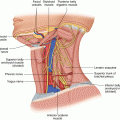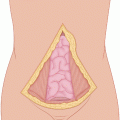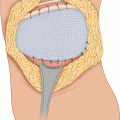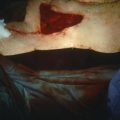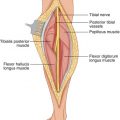(1)
State University of New York at Buffalo Kaleida Health, Buffalo, NY, USA
Node dissection of the external iliac, obturator, common iliac, and preaortic-precaval nodes is performed for primary tumors of the pelvis with a tendency for lymphatic spread, such as gynecologic tumors, genitourinary tumors, and colorectal tumors. The precise extent of node dissection depends on the known propensity of the specific tumor to spread to a certain area of the retroperitoneal nodal chain and on radiologic evidence (e.g., CT scan) detecting involvement of specific nodes. The extent of this dissection superiorly stops at the level of the renal vessels. It is possible to go a few centimeters higher by kocherizing the duodenum and exposing the inferior vena cava (IVC) and aorta behind the pancreas. Mobilization of the spleen and distal pancreas anteriorly by dividing the splenocolic and lienorenal ligaments (and usually the gastrosplenic ligament) allows the spleen to be brought to the surface of the wound and provides adequate exposure of the upper abdominal aorta, the celiac axis, and the superior mesenteric artery for the removal of abnormally enlarged nodes in this area.
The lymphatic spread of pelvic malignancies usually does not involve the external iliac and obturator nodes, but there are occasional exceptions. Often the retroperitoneal node dissection is done in combination with resection of the primary pelvic tumor.
Retroperitoneal node dissection is performed through a midline incision from the xiphoid to the pubic symphysis with the patient in a supine position. The peritoneal cavity is entered and a preliminary exploration is conducted to assess the extent of disease and to rule out findings of distant tumor spread (eg, bilateral liver metastases), which would negate the value of retroperitoneal node dissection.
The “white” line (Toldt’s line, the peritoneal reflection from the mesocolon to the parietal wall) lateral to the right colon is incised all the way up to and including the hepatocolic ligament. The areolar tissue next to the mesocolon is incised, exposing the right ureter and gonadal vessels inferiorly to the point where the ureter crosses the bifurcation of the common iliac artery and descends into the lesser pelvis. The right gonadal (internal spermatic) vein is traced superiorly to its point of entry into the IVC, where it may be ligated and divided if removal of this vein is indicated by the presence of adjacent abnormal lymph nodes. Extensive kocherization of the duodenum is carried out, exposing the IVC and aorta at this level. The right and left renal veins are exposed as they enter the IVC (Fig. 34.1).


Fig. 34.1




The lateral peritoneal reflection on the right side and the hepatocolic ligament are incised. The peritoneal incision continues around the ileocecal area all the way to the ligament of Treitz. Incising the peritoneal reflection of the left colon and sigmoid allows exposure and dissection of the left iliac and para-aortic nodes
Stay updated, free articles. Join our Telegram channel

Full access? Get Clinical Tree




